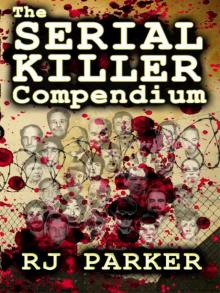- Home
- R. J. Parker
The Serial Killer Compendium
The Serial Killer Compendium Read online
Brought to you by KeVkRaY
THE SERIAL KILLER COMPENDIUM
By RJ Parker
E-Book Edition
Copyright © 2012 by RJ Parker
True Crime Publishing License Notes
This book is licensed for your personal enjoyment only. This book may not be re-sold or given away to other people. If you would like to share this book with another person, please purchase an additional copy for each recipient. If you’re reading this book and did not purchase it, or it was not purchased for your use only, then please return to the author and purchase your own copy. Thank you for respecting the hard work of this author.
THE SERIAL KILLER COMPENDIUM
Copyright © 2012 by RJ Parker
PAPERBACK ISBN # 978-1475017823
About the Author
RJ Parker resides in Eastern Canada where he spends his time doing what he loves best: reading and writing. Writing is relatively new to Parker, however, as he began writing after becoming disabled with Anklyosing Spondylitis, or arthritis of the spine. RJ is also a proud dad of two girls aged sixteen and twenty, as well as twin sons who are twenty-six. He recently turned and became a poppy.
Website: www.rjparker.net
FB: http://www.facebook.com/AuthorRJParker
Email: [email protected]
All books on Amazon: www.amazon.com/author/rjparkertruecrime
AN ASTOUNDING COMPILATION OF 50 OF THE MOST NOTORIOUS AND RUTHLESS SERIAL KILLERS THE WORLD HAS EVER SEEN.
From the author of TOP CASES of The FBI, Parker captures criminal files on 50 Serial Killers including: John Wayne Gacy, Ted Bundy, Jeffrey Dahmer, Son of Sam, Karla Homolka, Christine Fallings, Dr. H.H. Holmes, and many, many more.
This book includes, the Black Widows, Cannibals, Unsolved Serial Killings, and the various categories of Serial Killers as defined by the FBI.
Serial Killer Defined
A serial killer, as characteristically defined, is a person who has murdered three or more people over a period with a cooling off period between the murders. The motive for killing is typically based on psychological gratification. Many serial killers who are caught usually do not see a prison cell, but are put in a mental facility instead. Some sources label serial killing as a series of two or more murders, committed in separate events, by one criminal acting alone, or simply a minimum of at least two murders.
The FBI states that motives for serial murder include thrill, anger, rage, financial profit, and attention seeking, but often there is a sexual factor involved. In addition, a serial killer will normally target people who have something in common such as appearance (blonde-haired people with blue eyes), occupation (prostitutes), race (colored people), sex (females), or age groups (teenagers).
Serial Killers are not spree killers, someone who kills two or more people without a cooling off period, nor are they mass murderers, a person or a group who kills more than four people at one event.
The FBI defines serial murder as follows:
* A minimum of three victims, with periods off "cooling off" in between.
* The killer is usually a stranger to the victim, and the murders appear random.
* The murders reflect a need to viciously dominate the victim.
* The murder is rarely "for profit;" the motive is psychological, not material.
* Killers often choose victims who are vulnerable: prostitutes, runaways, etc.
* The typical serial killer is a white male from a lower to middle class background, habitually in his twenties or thirties. Several were bodily or psychologically abused by parents. As children, serial killers often set fires, torture animals, and wet their beds; these red flag behaviors are known as the triad of signs. Brain injuries are often common. Many are above intelligent and have revealed immense promise as successful people. They are also captivated with police and authority in general. They either will have endeavored to become police officers themselves but were rejected, or be employed as security guards, or have served in the military. Many of them, including John Wayne Gacy, Ted Bundy, and the Hillside Strangler, would camouflage themselves as law enforcement officials in order to gain entrance to their victims.
Attributes of a Serial Killer
* Over 90 percent of serial killers are white males.
* They have a propensity to be intelligent, with above-average IQs.
* Despite their high IQs, most do poorly in school and have difficulty in holding a job.
* Classically, they are neglected as children and were raised by domineering mothers.
* There is often a family history of psychiatric and alcoholic issues.
* They are generally abused mentally and sexually as children.
* A lot of them end up spending time in reform schools as children.
* They have a higher than normal rates of suicide attempts.
* From an early age, they have interests in fetishism, voyeurism, and pornography.
* Over 60% of serial killers were wetting their beds past the age of twelve.
* Fire starting: their attraction with fire is an early demonstration of their fondness for dramatic destruction. Otis Toole, the associate of Henry Lee Lucas, burned down a neighborhood house when he was just six years old. Teenage adventure killer George Adorno was only four years old when he first displayed his pyromaniac tendencies, setting fire to his own sister. The habitual Carl Panzram was thrown into a reformatory when he was only eleven years old, and just months after torched the place, causing damage in excess of over one hundred thousand dollars.
* Sadistic activity: serial killers get their enjoyment from tormenting small animals at an early age, later graduating from animals to human beings.
Organized or Disorganized
One of the many jobs of an FBI profiler is classifying the UNSUB or Unknown Subject, collecting facts about the crimes he or she committed for understanding and future knowledge.
FBI profiler, John Douglas, termed the words ‘disorganized’ and ‘organized’ in the study of serial killers. These differences can be contingent from facts and other information about the crime, or from the crime scene itself.
A disorganized, psychotic, or mentally ill individual, is inferred from a messy, disorganized crime scene with lots of evidence left behind. On the other hand, an organized killer, someone who shows no remorse, and is psychopathic, is controlled, planning, premeditated, and leaves behind very little, if any, evidence at a crime scene.
Organized Serial Killer Attributes:
IQ above average; 105-120 range
Socially adequate
Lives with partner or dates frequently
Stable father figure
Harsh family physical abuse
Geographically/occupationally mobile
Follows the news media
May be college educated
Good hygiene/housekeeping skills
Does not usually keep a hiding place
Diurnal (daytime) habits
Drives a flashy car
Needs to return to crime scene to see what police have done
Usually contacts police to play games
A police groupie
Doesn’t experiment with self-help
Kills at one site, disposes at another
May dismember body
Attacks using seduction, into restraints
Doesn’t dehumanize victims, converses with them
Leaves a controlled crime scene
Leaves little physical evidence
Responds best to direct interview
Disorganized Serial Killer Attributes:
IQ below average, 80-95 range
Socially inadequate
Lives alone, usually does not date
Absent or unstable father
Family emotional abuse, inconsistent
Lives and/or works near crime scene
Minimal interest in news media
Usually a high school dropout
Poor hygiene/housekeeping skills
Keeps a secret hiding place in the home
Nocturnal (nighttime) habits
Drives a clunky car or pickup truck
Needs to return to crime scene for reliving memories
May contact victim’s family to play games
No interest in police work
Experiments with self-help programs
Kills at one site, considers mission over
Usually leaves body intact
Attacks in a “blitz” pattern
Depersonalizes victim to a thing or it
Leaves a chaotic crime scene
Leaves physical evidence
Responds best to counseling interview
Noteworthy Facts
* H.H. Holmes, America's First Serial Killer, was convicted of nine murders; however, Holmes confessed to twenty-seven murders, and some investigators thought he might have actually murdered hundreds. When the World's Fair opened in Chicago in 1893, he began by killing guests at the enormous Castle Hotel. His crimes were discovered in an inspection after a janitor told police that he was not permitted to clean certain floors of the hotel. He was convicted and hanged three years later in 1896.
* Most of the victims of Jeffrey Dahmer and John Wayne Gacy, who were both white males, were men and boys of racial or ethnic minorities.
* Mary Bell was only ten years old when she was convicted of murdering two boys in England in 1968. After being confined first in an all-boys' reform school, she was later sent to a women's prison and was released at the age of twenty-three.
* The Son of Sam, David Berkowitz, was a thrill killer who enjoyed the excitement of the kill. He did not touch any of his fifteen victims, but instead followed and shot at them from a distance.
* Most serial killers are white males between the ages of twenty and thirty-five. In recent years, however, there has been an increase of serial killers from other races.
* The USA makes up 76% of the world’s serial killers. England has produced 28% of the European total.
* The western part of the United States such as California and Washington has produced more serial killers than any other part of the United States.
* Serial killers are often quite intelligent with an above average IQ.
* At any given time in the U.S., there are thirty to fifty unidentified active serial killers at work constantly changing their targets and methods; however, some authorities think that number is much higher.
* Runaways, prostitutes, and others who lead covert lives are usually not reported missing immediately and receive little police or media attention. This makes them extraordinary targets for killers.
* Experts hypothesize on what happens to unsolved cases of murderers. It is believed that some commit suicide, die, are imprisoned for other crimes, are put in mental institutions, move to another locations, or simply stop killing. Rarely do they turn themselves in.
* The term serial killer was coined in the 1970s by the FBI.
* Serial killers often suffer from Antisocial Personality Disorder, APD, and appear to be ordinary or even polite. Sometimes this is referred to as the mask of sanity. There’s often sexual characteristic to the murders, and killers may have a fondness for a particular gender, occupation, appearance, race, or other choices.
* As children, serial killers usually experience a significant amount of psychological, physical, and sexual abuse. Many times, it is a combination of all three. This vicious exploitation helps to motivate in them intense feelings of embarrassment and helplessness, which they usually impose upon their later victims.
* Many serial killers have a voracious appetite for unusual sexuality, and obsessions with fetishism, voyeurism, and aggressive pornography.
* Serial killers often have a comfort zone, committing their crimes to some extent close to their homes. They prefer to hunt for their victims at places they are familiar with, where they feel self-assured and in control. They know the best spots in the area to capture victims, and the quickest getaway routes.
How to catch a Serial Killer
How are serial killers caught? A killer continues to kill until he or she either is captured, dies, is put in jail for another crime, stops killing, or kills him or herself. After any homicide is committed, there is a thorough crime scene investigation and routine autopsies done on the victim, as well as many other steps in solving the crime.
Once all of this information has been collected, it is entered into a nationwide database run by the FBI as part of ViCAP (Violent Criminal Apprehension Program). This program can help determine different patterns, or signatures, that can link separate homicides done anywhere in the country.
A signature is a ritual, something the subject does intentionally for emotional satisfaction, something that is not necessary to perpetuate the crime. Some serial killers pose their victims in a certain way, or leave them in a certain place or position after killing them. This is an example of a signature. Another example might be a method of torture or dismembering. In short, it is what the killer does to accomplish his fantasies, and it can tell investigators a great deal about his personality and if he or she is organized or disorganized killer, which would also reflect on the intelligence of the killer.
Another method used in catching a serial killer is the establishment of an MO, or modus operandi, for the crime. The MO reflects the killer’s habits and what the killer had to do to commit the crime. This includes everything from luring and restraining his victim to the way that he actually murders; for example: their habitual choice of weapon. A serial killer's MO can change over time. Essentially, he or she learns from past blunders and improves with time. These are some of the components of criminal profiling.
Profiling Serial Killers
The Federal Bureau of Investigation developed the Behavioral Sciences Unit in 1972, using both signatures and MOs as aspects of profiling. Studies by psychologists and psychiatrists, and information gleaned from past serial murders, are compiled in the creation of a profile, along with crime scene information and witness statements. For example, if the victim is Caucasian, the killer is most likely Caucasian also, and if the crime scene demonstrates evidence of careful planning, the killer is most likely to be older, intelligent, and organized. A lot of it is theoretical, based on several studies and interviews of serial killers. Profiles are rarely 100% precise, but they are usually found to be very close.
After all the variables are compiled to make a profile, investigators can look at the existing list of suspects and ascertain which are most likely to have committed the crime and determine how best to apprehend him/her. Some organized serial killers, such as Dennis Rader, The BTK Killer, feel the need to mock the police, which sometimes leads to their arrest. In Rader’s case, he sent police a floppy disk containing data that was traced to his church. Many serial killers are unbelievably controlled and methodical, but also so arrogant that they slip up in some way that leads to their arrest. Jeffrey Dahmer, for instance, let a victim escape who then led police directly to Dahmer's apartment.
Not all serial killers are caught however, and in this book there are several unsolved serial killing cases. Yes, some are arrested or picked up for other crimes, and evidence leads investigators to their murders, but other times it’s just pure luck for the authorities or bad luck for the serial killer, that leads to their capture. For example, Ted Bundy was caught at a routine traffic stop, while David Berkowitz, The Son of Sam, was initially picked up for loitering and was thought to be a witness to the crimes instead of the killer.
Most serial killers either spend their lives in prison once convicted, or are executed if the death penalty exists in the state that prosecuted them. Of course, there’s always the exception to the rule.
For instance, Ed Gein was considered incompetent to stand trial and was sent to a mental facility, but his doctor later determined him to fit. The judge then found him not guilty because of insanity, and in 1984, he died of heart failure in prison.
Peter Woodcock is an example of no cure for a serial killer. He spent thirty-five years in a criminal ward at a psychiatric hospital in Ontario, Canada, after killing three children. Only hours after being released, he killed another psychiatric patient and was immediately sent back to the hospital. He’d been released as he was deemed cured by his psychiatrist, but obviously, even after thirty-five years, he was not cured.
Female Serial Killers
Female serial killers often remain unobserved, hiding in the background, masked by her male equal. Her acts are unusual and uncommon, but never fail. She behaves in a more delicate and precise manner, and is deadly and merciless. The most common of her monstrous crimes have not yet been comprehended. The theory of the female serial killer herself still lies within the specialty of uncertainty. It is time, however, to capture this hushed serial killer and bring her crimes to our attention.
What is the difference between a serial murderer from any other murderer? A murderer is usually defined as someone who takes the life of another person. A serial murderer usually murders more than three people.

 The Serial Killer Compendium
The Serial Killer Compendium Unsolved Serial Killings
Unsolved Serial Killings While You Slept
While You Slept Cold Blooded Killers
Cold Blooded Killers ABDUCTION: The Minivan Murders: Killer Couple Michelle Michaud and James Daveggio
ABDUCTION: The Minivan Murders: Killer Couple Michelle Michaud and James Daveggio The Dinner Party
The Dinner Party The Good Neighbor
The Good Neighbor